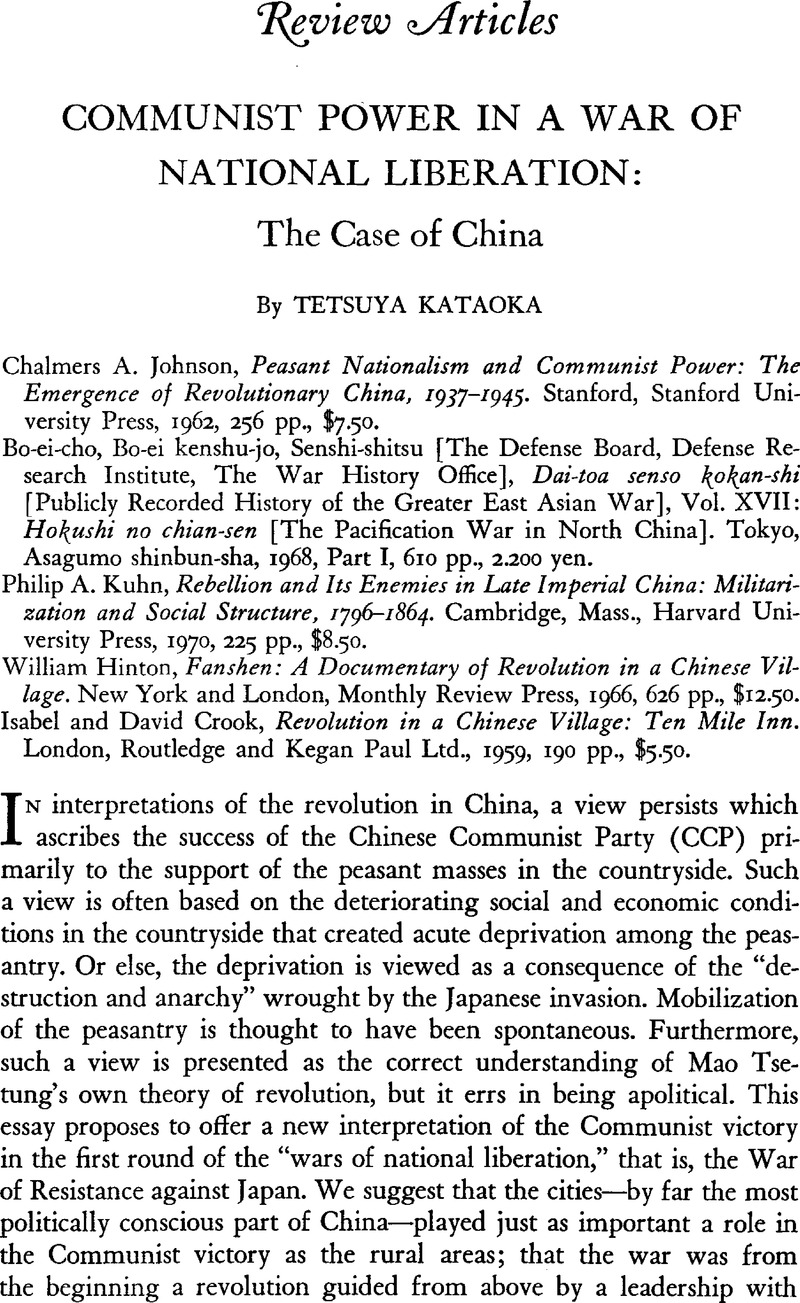Article contents
Communist Power in a War of National Liberation: The Case of China
Review products
Published online by Cambridge University Press: 18 July 2011
Abstract

- Type
- Review Article
- Information
- Copyright
- Copyright © Trustees of Princeton University 1972
References
1 Ch'en Shao-yu chiu-kuo yen-lun hsiian-chi [Collection of Ch'en Shao-yü's Save-the-Nation Speeches] (Hankow 1938), 1–107.
2 Chinese Communism and the Rise of Mao (Cambridge, Mass. 1958), 189–90.
3 Ch'en Shao-yü (fn. 1), 79. For a correct understanding of the Party line established at its Sixth Congress, see Thornton, Richard C., The Comintern and the Chinese Communists, 1928–1931 (Seattle 1969)Google Scholar. The struggle between Mao and Li Li-san parallels that between Mao and Wang Ming.
4 Jerome Ch'en, “Resolutions of the Tsunyi Conference,” China Quarterly, No. 40 (October-December 1969), 1–38; Chi-hsi Hu, “Hua Fu, the Fifth Encirclement Campaign and the Tsunyi Conference,” China Quarterly, No. 43 (July-September 1970), 31–46.
5 Kataoka, “Strategic Dispute between Mao and P'eng Te-huai in the War Against Japan,” paper read at the 32nd annual meeting of the Association for Asian Studies, April, 1970.
6 Thus the notion of “Maoism” as Schwartz defined it is incomplete. It is a partisan definition held both by Mao's detractors in their attack and by Mao himself in self-defense.
7 Kataoka (fn. 5).
8 John S. Service's report in U.S. Senate, Committee on the Judiciary, Subcommittee to Investigate the Administration of the Internal Security Act and Other Internal Laws, The Amerasia Papers: A Clue to the Catastrophe of China (Washington, D.C. 1970), 790; emphasis in original.
9 Tse-tung, Mao, Selected Worths (New York 1955), IV, 176Google Scholar.
10 Ibid., 189.
11 Ibid., 251.
12 See one such resolution in an appendix to Warren Kuo, “The Conflict between Chen Shao-yu and Mao Tse-tung, Part II,” Issues and Studies (December 1968). It is to be noted that the Sixth Plenum also passed such a Resolution.
13 See Barrington Moore's criticism of the functionalists in the context of Chinese history in Social Origins of Dictatorship and Democracy: Lord and Peasant in the Maying of the Modern World (Boston 1967), 484–508.
14 In “Introductory Remark to The Communist” Selected Works (New York 1955), III, 60.
15 Mao makes statements like these whenever he is contending with someone for power. It is his favorite rhetorical device to extoll the wisdom, virtue, and power of the people, and then to imply that they support him spontaneously. See an attempt to reconstruct Mao from short sentences like these in Maurice Meisner, “Leninism and Maoism: Some Populist Perspectives on Marxism-Leninism in China,” China Quarterly, No. 45 (January-March 1971), 2–36.
16 It is interesting to note that Wang Ming conceded this point in a speech made when the Kuomintang forces were about to overrun the Soviets. See Hsin-t'iao-chien yü hsin-ts'e-lüeh [New Conditions and New Policy] (Report to the Work Personnel Conference of the China Section, The Foreign Worker's Publishing House of the Soviet Union, November 24, 1934) (Moscow and Leningrad 1935). Thus, it seems that he was making apologies for the impending doom of the Kiangsi Soviets led by the Internationalists. Then, after the fall, he decided to blame Mao.
17 Chi Wu, I-ke ke-ming ken-chü-ti ti ch'eng-ch'ang [The Growth of One Revo-tionary Base] (Peking 1958), 84–85.
18 Mao (fn. 9), IV, 162–63.
19 Hsing-huo liao-yüan [A Single Spark Can Start A Prairie Fire] (Peking 1961), VI, 87. This was in northwestern Shansi where Communist power was extremely tenuous.
20 Mao (fn. 9), III, 221.
21 Defense Board, Defense Research Institute, War History Office, Dai-toa senso kokan-shi, XX: Daihonei rikugunbu [The Imperial Headquarters, the Army General Staff] (Tokyo 1968), Part II, 31–33, 237–39.
22 Mao (fn. 9),V, 81.
23 The Amerasia Papers (fn. 8), 814.
24 Our thesis can be substantiated by reference to the impressive case history compiled by Hinton. Hinton, however, draws an opposite conclusion, namely, that the revolution was spontaneous. Moreover, he has gone to the extreme in a sequel to Fanshen—a regrettable event, since it casts aspersion on Fanshen itself. “ ‘Fanshen’ Re-examined in the Light of the Cultural Revolution,” PL, No. 6 (February 1969).
25 Shen-Kan-Ning pien-ch'ü chien-cheng shih-shih yao-kang [Program for Implementing the Simplified Government in the Shen-Kan-Ning Border Region] (The Northwestern Bureau of the CCP, December 1942).
26 See how the Taiping Rebellion was frustrated by the lack of competent cadres in Kuhn, 189–96.
27 Mao (fn. 9), III, 81.
- 3
- Cited by


